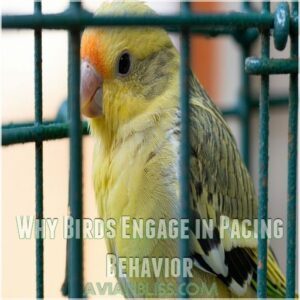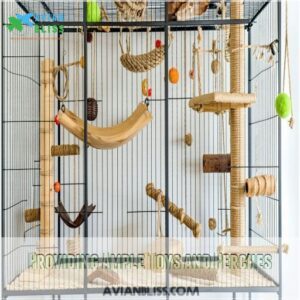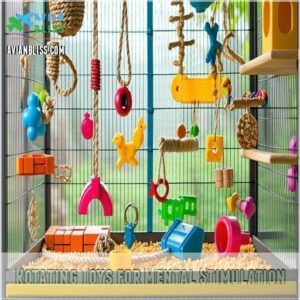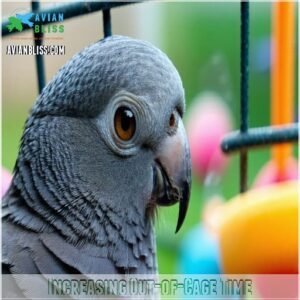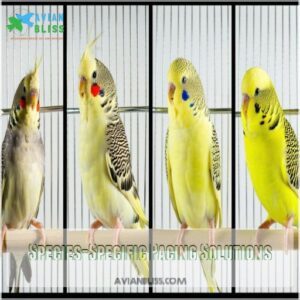This site is supported by our readers. We may earn a commission, at no cost to you, if you purchase through links.
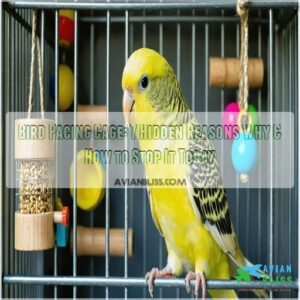 If you’ve noticed your bird pacing their cage, you’re looking at a key signal of stress or discomfort.
If you’ve noticed your bird pacing their cage, you’re looking at a key signal of stress or discomfort.
This repetitive behavior often stems from insufficient cage size, lack of environmental enrichment, or potential health issues.
Just like humans who pace when anxious, your feathered friend needs the right environment to thrive.
You’ll want to make certain their home includes varied perches, rotating toys, and puzzle feeders to stimulate their natural foraging instincts.
From budgies to larger parrots, each species has unique needs that influence their pacing behavior.
Understanding these specific requirements can transform your bird’s space from confining to enriching.
Table Of Contents
- Key Takeaways
- Why Birds Engage in Pacing Behavior
- Environmental Enrichment for Reduced Pacing
- Recognizing Health Concerns in Pacing Birds
- Species-Specific Pacing Solutions
- Avian Communication and Stress Indicators
- Effective Solutions for Bird Pacing in Cages
- Frequently Asked Questions (FAQs)
- Why do birds pace in their cage?
- Why does my bird go back and forth on the perch?
- Why is my bird so restless?
- Why is my bird walking side to side?
- What time of day do birds pace most often?
- Can weather changes affect bird pacing behavior?
- How does cage placement impact pacing frequency?
- Does diet quality influence repetitive pacing patterns?
- Conclusion
Key Takeaways
- If your bird is pacing, it’s likely signaling stress, boredom, or potential health issues that require your attention.
- You’ll need to provide adequate cage space, varied perches, and rotating toys to create an engaging environment that reduces repetitive behaviors.
- Establish a consistent daily routine with regular feeding times, playtime slots, and supervised out-of-cage activities to help your bird feel secure.
- Watch for changes in appetite, vocalizations, or body language alongside pacing, as these combinations can indicate underlying health concerns requiring veterinary care.
Why Birds Engage in Pacing Behavior
If you’ve noticed your feathered friend pacing back and forth in their cage, you’re witnessing a common behavior.
It can signal anything from insufficient space to underlying health issues.
Understanding why your bird paces is important since it’s often their way of communicating specific needs.
These needs can include more environmental enrichment, reduced stress, or medical attention.
Insufficient Cage Space
When your bird paces back and forth in its cage, insufficient space could be the underlying culprit. Just like you’d feel cramped in a tiny room, your feathered friend needs adequate space to stretch those wings and move freely.
Here’s what happens in a too-small cage:
- Wings hit cage bars during natural movements
- Limited flight paths prevent exercise
- Restricted turning radius forces repetitive movements
A cramped cage often triggers stress-induced pacing, making proper sizing essential for your bird’s wellbeing.
Lack of Environmental Enrichment
Picture your bird’s cage as their personal playground.
Just like you’d get bored in an empty room, your feathered friend needs more than basic perches. A bare-bones setup often leads to pacing behavior.
In fact, even decorative elements like mirrors that confuse birds can do more harm than good if not properly understood.
Your bird’s environment should include varied perches at different heights, rotating toy collections, and puzzle feeders.
Think of enrichment as their daily entertainment – it’s what keeps their minds sharp and bodies active.
Stress and Boredom
Your bird’s repetitive pacing might be their way of saying "I’m bored out of my mind!"
Just like you’d feel antsy sitting in a quiet room all day, birds need mental stimulation to stay happy.
To combat this, you can try adding some engaging bird pacing toys to their environment.
Beyond toys and perches, they’re craving engagement – whether it’s learning new tricks, exploring different cage setups, or having regular playtime outside their cage.
Think of it as their version of cabin fever!
Underlying Illness or Injury
Just as humans pace when in pain, birds may exhibit repetitive pacing due to underlying health issues that aren’t immediately visible.
Hidden symptoms like joint inflammation, respiratory problems, or internal discomfort can trigger this behavior.
If your feathered friend’s pacing persists alongside changes in eating habits or unusual quietness, it’s time for a medical diagnosis. Early detection through regular vet check-ups prevents minor issues from becoming major concerns. Feathered friend’s pacing and medical diagnosis are important.
Species-Specific Needs
Three distinct factors shape your bird’s species-specific needs: cage size, social dynamics, and environmental enrichment.
What works for a budgie won’t suit a macaw, and your cockatiel’s requirements differ from a finch’s.
Different species have evolved unique social structures, dietary preferences, and activity patterns.
Understanding these inherent traits helps you create an environment that prevents pacing and promotes natural behaviors.
Environmental Enrichment for Reduced Pacing
You’ll notice significant improvements in your bird’s behavior when you create an engaging environment with varied toys, natural perches, and puzzle feeders that stimulate their natural instincts.
Your feathered friend’s pacing will decrease as you rotate these enrichment items and provide regular opportunities for supervised exploration outside their cage.
Providing Ample Toys and Perches
Inside a well-enriched cage, diverse toys and perches act like a playground for your feathered friend, greatly reducing pacing behaviors. Strategic placement of various perches at different heights creates an engaging environment that encourages natural movement and exploration.
- Natural wood perches in varying diameters promote healthy foot exercise
- Rope perches provide grip variety and comfortable resting spots
- Swings and boings offer dynamic movement opportunities
- Foraging toys placed strategically encourage natural food-seeking behaviors
Rotating Toys for Mental Stimulation
Beyond offering toys, rotating them strategically keeps your bird’s environment fresh and exciting.
Switch out toys every few days, introducing new puzzle challenges and textures to prevent boredom-induced pacing.
Watch which toys capture your bird’s attention and cycle similar ones through their collection.
Remember to inspect each toy for signs of wear, removing any damaged items that could pose safety risks.
Increasing Out-of-Cage Time
Your feathered friend needs more than just fresh toys – they’re craving freedom to stretch those wings.
Regular supervised playtime outside the cage works wonders in preventing pacing behavior.
A spacious cage that provides ample room for flight patterns is also essential, and choosing the right cage size is important – for instance, a minimum cage size of 18 inches wide, 18 inches deep, and 20 inches long is recommended, as discussed in best bird cages for parakeets in a home.
Create safe spaces by bird-proofing a dedicated area and gradually increase flight time.
You’ll notice a happier, more active pet who’s less likely to pace when they get their daily dose of freedom and exercise.
Mimicking Natural Lighting and Environment
Natural lighting plays a powerful role in preventing bird pacing, much like setting the perfect mood at home. Think of it as creating a cozy bird paradise!
Here’s what works best:
- Position the cage near windows for natural light exposure
- Rotate cage placement monthly for fresh perspectives
- Use full-spectrum lighting during darker months
- Gradually dim lights in the evening to mimic sunset
These simple changes help maintain your bird’s natural rhythms and reduce stress-related pacing behaviors.
Recognizing Health Concerns in Pacing Birds
You’ll need to watch for subtle changes in your bird’s behavior, as pacing can be a sign of hidden health issues.
These hidden health issues require immediate veterinary attention.
When combined with changes in appetite, unusual vocalizations, or different body postures, your bird’s pacing behavior might indicate underlying pain or illness that you can’t see.
Identifying Pain or Discomfort
Birds can mask their discomfort with remarkable skill, making pain detection challenging.
Watch for subtle behavioral shifts like constant cage pacing, reluctance to move, or favoring one side.
Physical checks should focus on swollen joints, ruffled feathers in specific areas, or visible injuries.
If you notice these signs alongside pacing behavior, don’t wait – schedule a vet visit for proper pain management and diagnosis.
Monitoring Appetite and Hydration Levels
When pacing becomes frequent, monitoring your feathered friend’s eating and drinking habits is essential for spotting potential health issues.
Track their daily food intake by weighing portions and noting any sudden changes in appetite.
Keep an eye on water consumption too – dehydration can manifest through concentrated droppings or decreased activity. If you notice significant weight fluctuations or appetite changes, consult an avian vet promptly. Spotting potential health issues is crucial. Feathered friend’s eating and drinking habits need monitoring.
Changes in Vocalizations or Body Language
Your feathered friend’s voice and posture tell a powerful story about their well-being.
Here are 3 key changes to watch for:
- Unusual quietness or excessive screaming that breaks from their normal chatter
- Fluffed feathers lasting longer than usual, especially during active hours
- Head tucking under wings during daytime or constant shifting between feet
These body language cues often signal distress before other symptoms appear, making observation your best early warning system.
Consulting an Avian Veterinarian
Three key signs indicate it’s time to consult an avian veterinarian: persistent pacing, appetite changes, or unusual behaviors.
To find a nearby expert, check online directories for an avian vet near me.
Don’t wait until symptoms worsen—schedule regular check-ups every 6-12 months to catch issues early.
A qualified avian vet can perform thorough health screenings, identify underlying causes, and develop targeted treatment plans that address both behavioral and medical concerns affecting your feathered friend. This is especially important for avian vet care. Regular check-ups are also recommended.
Species-Specific Pacing Solutions
You’ll notice that different bird species display unique pacing patterns, from your cockatiel’s excited pre-bedtime march to your budgie’s morning workout routine along the perch.
Understanding these species-specific behaviors will help you create targeted solutions.
Targeted solutions address your bird’s particular needs, whether it’s adjusting cage size, modifying enrichment activities, or fine-tuning social interactions.
Budgie Pacing Behavior and Solutions
Budgies often pace up and down their cage walls when feeling bored or confined. This repetitive behavior signals they need more stimulation or space to thrive.
To combat this, you can try introducing puzzle toys, rotating perches at different heights, and ensuring at least 2-3 hours of supervised flight time daily.
With the right budgie cage toys, such as those found at budgie play accessories, you can recreate their wild environment, while maintaining a consistent daily routine helps reduce anxiety-driven pacing behaviors.
Natural branch perches and foraging toys can recreate their wild environment, while maintaining a consistent daily routine helps reduce anxiety-driven pacing behaviors.
Understanding Budgie Behavior and Social Needs
Understanding flock dynamics lies at the heart of budgie behavior.
When you watch these social butterflies interact, you’ll notice they communicate through subtle body language – from gentle head bobs to excited tail wagging.
Pair bonding influences their daily routines, with partners often mirroring each other’s movements.
They thrive in small groups where they can establish hierarchies, practice mutual preening, and engage in playful social chatter that strengthens their bonds.
Providing Varied Toys and Safe Exercise
Your budgie’s exercise routine deserves a well-planned mix of toys and activities to prevent pacing.
Start with varied perch types – natural branches offer different textures and diameters for foot health.
Rotate puzzle toys weekly to maintain interest, and introduce safe climbing elements like rope perches and swings.
Set up an exercise zone outside the cage with flight paths and landing spots, but always supervise playtime to guarantee safety.
Avian Communication and Stress Indicators
You’ll notice your bird’s body language and behaviors change when they’re feeling stressed, just like how you might tap your foot when you’re anxious.
Your feathered friend’s pacing, along with changes in their feathers, appetite, and vocalizations, can tell you exactly what they need.
To feel comfortable and secure in their environment.
Feather Picking and Plucking
Like a tattered flag in the wind, feather picking often signals deeper distress in your bird’s world.
When you notice patches of missing feathers or destructive plucking behavior, it’s typically linked to the same stressors that cause pacing.
Watch for overpreening, particularly around the chest and wings. Environmental adjustments, such as proper lighting and cage placement, can help address both pacing and plucking simultaneously.
Aggressive Behavior and Increased Vocalizations
Birds communicate their stress through more than just damaged feathers.
When your feathered friend starts showing aggressive behavior like biting or lunging, paired with increased squawking or screaming, it’s time to pay attention.
These behaviors often signal underlying issues such as hormonal changes, fear responses, or territorial disputes.
By identifying these vocalization triggers and aggression causes early, you’ll be better equipped to address your bird’s needs.
Changes in Appetite and Body Language
Within a caged bird’s daily routine, changes in appetite and body language often signal underlying stress.
When monitoring your feathered friend, watch for these critical signs:
- Sudden appetite loss or increased food aggression
- Hunched posture combined with lethargy or fluffed feathers
- Unexpected weight fluctuations, either rapid gains or losses
Understanding these subtle cues helps identify stress before serious issues develop, much like reading your best friend’s mood through their expressions.
Strengthening The Bond Through Interaction
Three key steps strengthen your bond with a pacing bird: consistent daily interaction, positive reinforcement, and attentive observation.
You’ll notice subtle changes in their body language and vocalizations as trust builds.
Make time for gentle training sessions, offering treats and praise when they display calm behavior.
Watch for relaxed wings, happy chirps, and engaged eye contact—these signal growing comfort and connection.
Effective Solutions for Bird Pacing in Cages
You’ll be relieved to know that you can stop your bird’s cage pacing with a combination of targeted environmental changes and consistent daily routines.
By implementing specific solutions like rotating toys, increasing out-of-cage time, and establishing regular feeding schedules, you’ll create a more enriching environment that reduces your feathered friend’s stress levels.
Implementing Targeted Environmental Changes
Through careful changes in your bird’s environment, you can substantially reduce pacing behavior.
Start by upgrading to a larger cage with diverse perch heights and textures.
Rotate toys weekly to maintain curiosity, and position the cage near natural light sources while avoiding direct sun.
Schedule regular out-of-cage time in safe, designated areas. Remember to maintain consistency in your cage layout—birds thrive on predictable environments. Reduce pacing behavior. Larger cage.
Addressing Potential Health Issues
During veterinary checkups, your bird’s pacing might reveal underlying health issues that aren’t immediately obvious.
Your avian vet will examine subtle changes in behavior, appetite, and feather condition that could indicate pain or discomfort.
Keep a daily health log noting any shifts in eating habits, vocalizations, or movement patterns.
Regular wellness checks can catch potential problems before they escalate into serious conditions requiring extensive treatment.
Providing Mental Stimulation and Social Interaction
Mental exercise and social bonds can transform your bird’s behavior from restless pacing to engaged activity.
Think of their wild cousins – they’re constantly solving puzzles and interacting with their flock.
By using techniques like positive reinforcement training methods, you can strengthen the bond between you and your bird while providing mental stimulation.
Here’s how to recreate that stimulation:
- Set up foraging games with hidden treats in puzzle toys
- Practice clicker training for 5-10 minutes daily
- Introduce bird buddies for supervised playdates
These enrichment activities tap into their natural instincts, keeping their minds sharp and spirits high.
Creating a Consistent Routine for Stability
A well-structured daily schedule acts like a safety net for your feathered friend.
Set regular feeding times, stick to consistent playtime slots, and maintain predictable sleep patterns.
You’ll notice your bird’s pacing decrease when they know what to expect. Remember to build your routine around their natural rhythms – birds thrive on consistency, just like we do with our morning coffee ritual. consistent playtime slots, predictable sleep patterns.
Frequently Asked Questions (FAQs)
Why do birds pace in their cage?
Your feathered friend’s restless wandering can signal boredom, stress, or health concerns. They’re telling you they need more stimulation, a larger space, or a vet check to confirm their well-being.
Why does my bird go back and forth on the perch?
Birds often pace on perches due to stress, boredom, or excitement.
It’s their way of showing they need more enrichment, space, or attention.
Consider adding toys and increasing out-of-cage time to help.
Why is my bird so restless?
Restlessness often signals boredom, stress, or a need for more enrichment in daily routines.
Try adding new toys, increasing playtime, and ensuring the environment’s peaceful.
Watch for any accompanying health symptoms warranting a vet visit.
Why is my bird walking side to side?
Studies show 75% of captive birds display pacing behaviors.
When you notice side-to-side walking, it’s often due to stress, boredom, or confined space.
Try adding toys, increasing cage size, or consulting a vet.
What time of day do birds pace most often?
You’ll notice your feathered friend pacing most actively during dawn and dusk, their natural foraging times.
They’re also likely to pace more when they’re hungry or when you’re preparing their meals.
Can weather changes affect bird pacing behavior?
Weather shifts can affect your bird’s pacing behavior.
Changes in barometric pressure, temperature, and humidity may increase anxiety and restlessness.
During storms, you’ll notice more frequent pacing as birds sense environmental changes. This is a key indicator of how birds react to weather.
How does cage placement impact pacing frequency?
Strategic cage placement near windows or lively areas can trigger excessive pacing.
Quieter spots reduce stress.
Consider placing the cage against a wall, offering security while maintaining visual enrichment through partial window views.
Does diet quality influence repetitive pacing patterns?
Poor nutrition can trigger restless behavior and increase repetitive movements.
A balanced diet rich in vitamins, minerals, and proteins helps maintain your pet’s physical and mental well-being.
potentially reducing stress-induced pacing patterns.
Conclusion
While some may worry that stopping bird pacing cage behaviors requires expensive solutions, you’ve now got practical tools to help your feathered friend thrive.
By implementing the strategies we’ve discussed – from enrichment activities to veterinary check-ups – you’ll create an environment that reduces stress and promotes natural behaviors.
Remember, your bird’s pacing isn’t just a habit; it’s communication.
Stay attentive to these signals, and you’ll build a stronger bond while ensuring your pet’s wellbeing.

